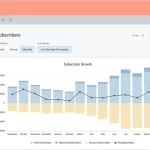
Let’s be honest. The subscription model is a beautiful thing. Predictable revenue, loyal customers, a business that hums along month after month. It feels like you’ve finally cracked the code.
But then you look at your books. That beautiful, predictable revenue becomes a tangled mess of deferred income, unrecognized revenue, and confusing cash flow statements. Suddenly, the simple act of knowing how profitable you truly are feels like trying to solve a Rubik’s cube in the dark.
Here’s the deal: traditional accounting, built for one-time sales, falls flat on its face with subscriptions. You need a new playbook. Let’s dive into the accounting strategies that will bring clarity, compliance, and genuine insight to your recurring revenue engine.
The Core Challenge: Why Cash in the Bank Isn’t Revenue
This is the biggest mental shift. When a customer pays you $120 for an annual plan, you don’t get to book $120 of revenue today. That cash is a liability. You owe them a year of service.
Think of it like a magazine subscription. You pay upfront, but the publisher only “earns” that revenue as each issue is mailed out. It’s the same for your SaaS platform, streaming service, or curated snack box. This is the heart of accrual accounting and the principle of revenue recognition.
ASC 606 and IFRS 15: The Rulebooks You Can’t Ignore
These accounting standards (ASC 606 in the U.S., IFRS 15 internationally) aren’t just suggestions. They’re the law of the land for financial reporting. They dictate a five-step model for revenue recognition:
- Identify the contract with a customer.
- Identify the performance obligations (what you’re promising to deliver).
- Determine the transaction price.
- Allocate the price to the performance obligations.
- Recognize revenue as you satisfy those obligations (usually over time).
For most subscriptions, satisfying the obligation means providing access day-by-day. So, you recognize revenue ratably—a fancy word for evenly—over the subscription period.
Key Metrics: The Pulse of Your Subscription Business
If you’re only tracking total revenue and profit, you’re flying blind. You need a dashboard of specific metrics that tell the real story.
| Metric | What It Tells You |
| Monthly Recurring Revenue (MRR) | The predictable revenue you can expect every month. The lifeblood. |
| Annual Recurring Revenue (ARR) | MRR multiplied by 12. Great for long-term vision. |
| Customer Lifetime Value (LTV) | The total revenue you expect from an average customer. A measure of longevity. |
| Customer Acquisition Cost (CAC) | How much you spend to get a new customer. The other side of the LTV coin. |
| Churn Rate | The percentage of customers who cancel. The leak in your bucket. |
Honestly, if your accounting system isn’t helping you calculate these, it’s time for an upgrade. These aren’t vanity metrics; they’re the steering wheel for your entire strategy.
Practical Accounting Playbook: Making It Work Day-to-Day
Okay, enough theory. How do you actually do this?
1. Mastering Deferred Revenue
This is your key adjusting journal entry. When you receive an annual payment of $1,200, you don’t hit the revenue account. The entry looks more like:
- Debit: Cash – $1,200
- Credit: Deferred Revenue (a liability account) – $1,200
Then, at the end of each month, you recognize one month’s worth of that payment.
- Debit: Deferred Revenue – $100
- Credit: Revenue – $100
This moves the money from the liability column to the earned revenue column. It’s a continuous, rolling process.
2. Handling Different Subscription Scenarios
Not all subscriptions are created equal, and your accounting needs to be nimble.
Usage-Based Billing (Metered): Think AWS or your cell phone data plan. Here, revenue recognition happens after the usage occurs. You bill in arrears. The accounting is more event-driven, but the principle remains—recognize revenue as the service is consumed.
Tiered Plans & Add-ons: If a customer is on a “Pro” plan that includes support and advanced analytics, you have multiple performance obligations. You need to allocate the subscription price to each element and recognize revenue for each part as it’s delivered. It gets complex, fast.
One-Time Setup Fees: A common pain point. You can’t just recognize this fee upfront. You have to ask: “Is this setup fee a separate service, or is it part of providing the ongoing subscription?” Often, it’s amortized over the life of the customer contract. Yeah, it’s a nuance that trips up a lot of smart people.
The Tech Stack: Your Accounting Co-Pilot
Doing this with spreadsheets is a recipe for burnout and errors. You need tools that talk to each other.
- A modern subscription billing platform (like Stripe, Chargebee, Recurly) is non-negotiable. They handle the intricacies of proration, dunning (failed payment recovery), and can often generate the deferred revenue schedules for you.
- This platform should integrate seamlessly with your accounting software (like QuickBooks Online, Xero, or NetSuite). The goal is automation. The billing system pushes the journal entries for recognized revenue, and your accountant can then work with clean, accurate data.
Investing in this integration isn’t an expense; it’s an investment in sanity and scalability.
The Big Picture: Why This All Matters
Getting subscription accounting right isn’t just about compliance. Sure, you need it for audits, taxes, and if you ever want to seek funding (investors will tear your financials apart if this is wrong). But the real value is deeper.
It’s about understanding your business’s true health. When you properly match revenue with the period it was earned, you get an honest picture of profitability. You can see which customer segments are actually valuable, which plans are working, and where your leaks are.
It transforms your accounting from a historical record-keeping exercise into a forward-looking strategic asset. Your financial statements stop being a confusing report and start being a crystal-clear map of your business journey.
And that, in the end, is the ultimate subscription—not just to a service, but to clarity itself.







